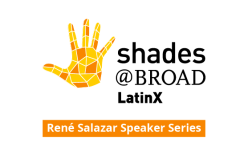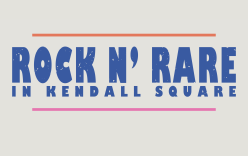Congratulations! You're doing great in the polls. That's according to a recent Pew Research Center survey that studied 4,500 Americans' perceptions of research scientists. Overwhelming majorities see you as "intelligent," "honest," "focused on solving real-world problems," and "skilled at working in teams." That old stereotype that scientists are "socially awkward"? Survey says it's on the way out.
Don't rest on your laurels, though: barely half of those surveyed describe you as "good communicators." Fortunately, you have resources aplenty to help you win over the remaining 46 percent:
-
The Broad Research Communication Lab (CommLab) offers writing, speaking, and visual support for scientists. Schedule a one-on-one coaching session with a CommLab fellow, or consult the CommKit, a collection of quick guides to successful scientific communication.
-
People Development also has help. Hop on over to MyLearning to browse People Development’s catalog of in-person skills workshops and self-directed tutorials that can help you rise to the toughest communication challenges: crafting an elevator pitch, asking for and receiving feedback, approaching difficult conversations, and more.
-
If you have news you’d like to share, or know of an incredible story worth telling at (and beyond) the Broad Institute, reach out to Communications.
Now sit back, relax, and read the week’s news of how intelligent, honest Broadies are working in teams to solve real-world problems:
Whence came the skeletons of Roopkund Lake?
Within a Himalayan pool called Roopkund Lake lie the bones of several hundred people, their identities and fates a mystery since their discovery decades ago. In Nature Communications, an international team led by Éadaoin Harney (Harvard University), Ayushi Nayak (Max Planck Institute for the Science of Human History), Douglas Kennett (University of California, Santa Barbara), Kumarasamy Thangaraj (CSIR Centre for Cellular and Molecular Biology), Niraj Rai (Birbal Sahni Institute of Palaeosciences) and David Reich report that DNA from 38 of the lake's skeletons reveal that the remains represent at least three genetically distinct groups, interred in the lake over the course of a thousand years (as opposed to all at once). Read more in The New York Times, The Atlantic, and National Geographic.
Ketogenic diet boosts intestinal stem cell function
Dietary nutrients are known to play a role in the maintenance of adult stem cells. However, little is known about how stem-cell generated metabolites coordinate cell function and physiology. To identify specific metabolic pathways, a team led by Chia-Wei Cheng, Moshe Biton, Adam Haber, Aviv Regev, Omer Yilmaz, and others, with help from the Genomics Platform, studied mouse intestinal stem cells (ISCs) that express the ketone-producing enzyme HMGCS2. Ketones provide energy to tissues during periods of low-energy states, such as fasting or prolonged exercise, and have also been implicated as signaling metabolites. Reporting in Cell, the researchers confirm that metabolites associated with a ketogenic diet improve ISC function and a glucose-rich diet has the opposite effects. Read more in MIT News.
A starring role for an immature cell
Treatments for pilocytic astrocytoma (PA), the most common pediatric brain tumor, can damage growing brains and bodies. A team led by Zachary Reitman, Brenton Paolella, Pratiti Bandopadhayay, and Rameen Beroukhim performed single-cell RNA sequencing of PA tumors to better understand their cellular makeup. They discovered that PA tumors comprise mostly mature, astrocyte-like cancer cells along with some immature cancer cells showing activity in the MAPK pathway, a potential target for safer therapies. Differences in tumors’ immune cell populations may explain inconsistent patterns of gene expression from different brain locations. Read more in Nature Communications and from Boston Children’s Hospital.
CRISPR makes material “smart”
Jim Collins and his team have made DNA hydrogels bend to their will, thanks to the programmable Cas12a enzyme. In a paper in Science, they show how they incorporated DNA into the structure of hydrogels. They then designed guide RNAs to get Cas12a to cleave the DNA in various ways, changing the behavior and properties of the gels. In one of several applications, the researchers used the Cas enzyme to release DNA-anchored compounds from a polyethylene glycol gel. Such CRISPR-responsive materials could be used in tissue engineering, molecular diagnostics, and bioelectronics. Read more from Nature news.
Get to know Bioethics@Broad
Scientific research often gives rise to questions that the scientific method alone is not equipped to answer. What are the limits to brain organoid research? How should we handle inequalities in access to scientific tools and data? Questions like these fall under the domain of bioethics, the evaluation of conflicts between competing values in health and medicine. On the Broadminded blog, Elinor Karlsson, Lisa Moses, and others explain how the recently-launched Bioethics@Broad group is providing Broadies a forum for practical, problem-solving bioethical reflection and discussion — all thanks to a cat named Darwin.
Now in preprint
-
Assessment of computational methods for the analysis of single-cell ATAC-seq data (Huidong Chen, Luca Pinello, and colleagues)
-
Prevalence and clinical importance of titin truncating variants in adults without known congestive heart failure (James Pirruccello, Amit Khera, and colleagues)
-
Polygenic hyperlipidemias and coronary artery disease risk (Samuli Ripatti and colleagues)
-
Modeling functional enrichment improves polygenic prediction accuracy in UK Biobank and 23andMe data sets (Carla Márquez-Luna, Alkes Price, and colleagues)
In the news
Aviv Regev and Joshua Weinstein talk with Nature about spatially mapping the gene-expression patterns of cells within their tissue context. Anne Carpenter is quoted in a Nature Reviews Drug Discovery feature on machine learning approaches to cell imaging. Bina Venkataraman's TED talk on securing our future for new generations is now online. Eric Lander, David Liu, Stuart Schreiber, and Feng Zhang signed an open letter in Nature supporting scientists from China, and American-born scientists of Chinese heritage, who are working and collaborating in the United States.
What to do next week (and beyond)
Want a child who's special to you to experience the Broad firsthand? Enter them in the lottery for the October 2019 and February 2020 Take Your Little Broadie to Work Days by Friday, September 6.
BITS is upgrading Broad’s telephone service to Dialpad, meaning you’ll soon be able to make and receive calls using your Broad phone number anywhere on (almost) any device. Learn about what you can do with DialPad and when it’s coming to a phone, mobile device, or computer near you.
Prepare for the next BITS maintenance window, taking place Saturday, September 14th. Many services will be unavailable for portions of this moderately disruptive maintenance window. Visit the BITS blog for an up-to-date list of planned work.
There’s a lot more going on. See the CalendarBroad for August 26–30 for more talks, meetings, and special events.
Have a good weekend, and… hey, you, with the yogurt: kindy dispose of the empty container in an appropriate receptacle. The Cambridge police will thank you.
-The BroadCast team
David Cameron
Allison Dougherty
Leah Eisenstadt
Amanda Dykstra Esposito
Corie Lok
Namrata Sengupta
Tom Ulrich
Sarah Vincent
Karen Zusi
Have a tip for a future BroadCast? Want to tell us what you thought of this one? Write to the BroadCast team. Wednesday at noon is the deadline to submit items for Friday publication.





